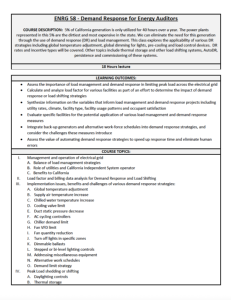ENRG 58: Demand Response for Energy Auditors

Program Description:
The Commercial Building Energy Analysis and Audits program at City College of San Francisco prepares students to conduct energy audits, evaluate building systems for efficiency, analyze energy data, and apply financial and business strategies in audit reporting. The program is divided into 15 modular courses designed for a community college level student. These courses are adaptable and can be selected, reorganized, or offered in a shorter format to suit individuals with experience in construction, architecture, HVAC, building operations, or mechanical engineering.
Course Description:
This course, from the BEST Center and City College of San Francisco, focuses on demand response for energy auditors. During the course, students are asked to consider applicability of various DR strategies including global temperature adjustment, global dimming for lights, pre-cooling and load control devices, DR rates and incentive types, thermal storage and other load shifting systems, AutoDR, persistence, and commissioning of these systems. In completing the course, students will be able to:
- Assess the importance of load management and demand response in limiting peak load across the electrical grid.
- Calculate and analyze load factor for various facilities as part of an effort to determine the impact of demand response or load shifting strategies.
- Synthesize information on the variables that inform load management and demand response projects including utility rates, climate, facility type, facility usage patterns and occupant satisfaction.
- Evaluate specific facilities for the potential application of various load management and demand response measures.
- Integrate back-up generators and alternative work-force schedules into demand response strategies, and consider the challenges these measures introduce.
- Assess the value of automating demand response strategies to speed up response time and eliminate human errors.
Course Contents:
Course resources include a course outline and six PowerPoint presentations.
The 3-page course outline includes a course description, learning outcomes, a detailed course topics outline, and more. Topics include: management and operation of electrical grid, load factor and billing data analysis for demand response and load shifting, implementation issues, benefits and challenges of various demand response strategies, peak load shedding or shifting, back-up generation and co-generation, commissioning of load management systems and, utility pricing signals and auto demand response.
The PowerPoint presentations cover an introduction to the course, an introduction to demand response, demand response and the smart grid, management and operations of the smart grid, demand response implementation, and demand limit strategy.
For orientation purposes, viewers should begin with ENRG 58_Course Outline_cc.pdf, which offers a description of the course as well as an overview of topics covered.
Below is a list of the files contained within the .zip attachment. The size of each file is included in parenthesis.
ENRG-58-DR-for-Energy-Auditors (15 files, 14.7 MB)
- Demand Response for Energy Auditors (DR1.pdf 554 KB)
- Demand Response for Energy Auditors (DR1.ppt 611 KB)
- What is Demand Response (DR2.pdf 326 KB
- What is Demand Response (DR2.ppt 105 KB)
- What id Meant by Smart Grid (DR3.pdf 822 KB)
- What id Meant by Smart Grid (DR3.ppt 1.7 MB)
- Management and Operation of the Electrical Grid (DR4.pdf 940 KB)
- Management and Operation of the Electrical Grid (DR4.ppt 663 KB)
- How do you know if you're a good candidate? (DR5.pdf 786 KB)
- How do you know if you're a good candidate? (DR5.ppt 467 KB)
- Implementation Table (DR6.pdf 4.3 MB)
- Implementation Table (DR6.ppt 3 MB)
- Course Outline (ENRG 58_Course Outline.docx 26 KB)
- Course Outline (ENRG 58_Course Outline.pdf 351 KB)
About this Resource


Comments